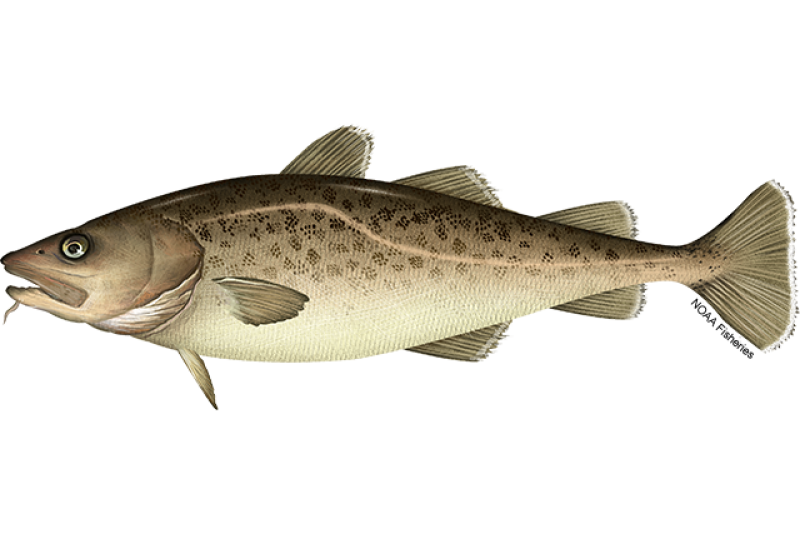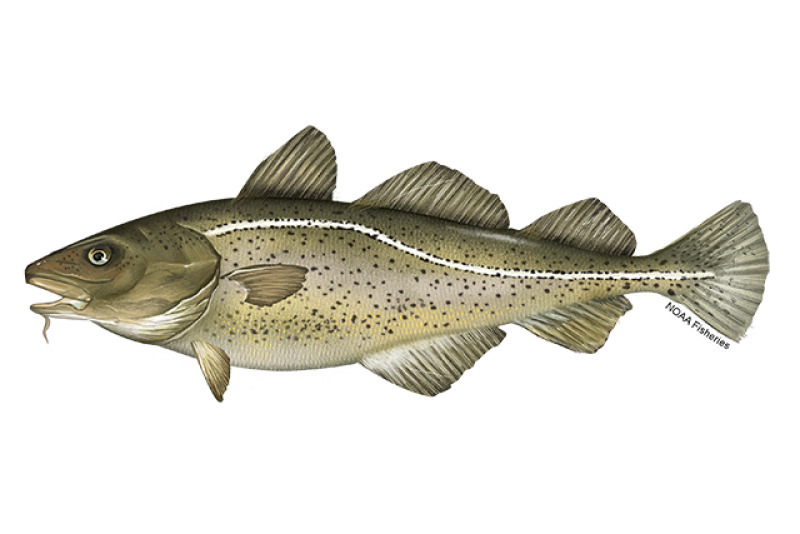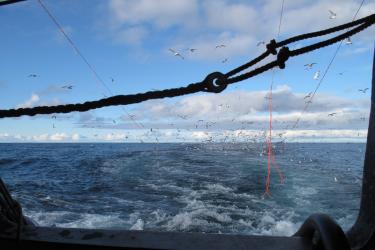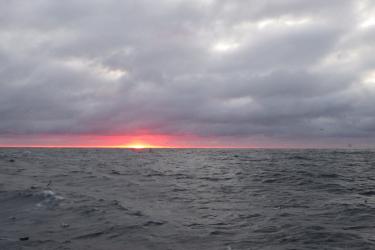 Pacific cod. Credit: NOAA Fisheries
Pacific cod. Credit: NOAA Fisheries
Pacific cod. Credit: NOAA Fisheries
About the Species
 Pacific cod. Credit: NOAA Fisheries
Pacific cod. Credit: NOAA Fisheries
Pacific cod. Credit: NOAA Fisheries
U.S. wild-caught Pacific cod is a smart seafood choice because it is sustainably managed and responsibly harvested under U.S. regulations.

Population
The Bering Sea and Gulf of Alaska stocks are not overfished. The Aleutian Islands and Pacific Coast stocks have not been assessed. Although these population levels are unknown, management measures are in place.

Fishing Rate
Not subject to overfishing.

Habitat Impact
Area closures and gear restrictions protect habitat that are affected by some types of fishing gear used to harvest Pacific cod.

Bycatch
Measures restricting the type of gear fishermen may use and when and where they may fish reduce bycatch of other species in the U.S. Pacific cod fisheries.
Population Status
- There are four stocks of Pacific cod: Bering Sea, Gulf of Alaska, Aleutian Islands, and Pacific coast. According to the most recent stock assessments:
- The Bering Sea stock is not overfished (2023 stock assessment) and not subject to overfishing based on 2023 catch data. Summary stock assessment information can be found on Stock SMART.
- The Gulf of Alaska stock is not overfished (2023 stock assessment) and not subject to overfishing based on 2023 catch data. Summary stock assessment information can be found on Stock SMART.
- The Aleutian Islands stock is not subject to overfishing based on 2023 catch data, but data are insufficient to determine the population status at this time (2023 stock assessment). Summary stock assessment information can be found on Stock SMART.
- The Pacific coast population of Pacific cod has never been formally assessed, but is not subject to overfishing based on 2022 catch data.
- In Alaska, scientists and managers determine the population status of Pacific cod based on estimates of spawning biomass—a measure of the number of females in the population that are able to reproduce.
- Estimated biomass has fluctuated over the past few decades; the stock increased rapidly, peaked in the 1980s, then declined slightly and stabilized.
Appearance
- Pacific cod are also known as gray cod because of their color—they’re brown or grayish with dark spots or patterns on the sides and a paler belly.
- They have a long chin barbell (a whisker-like organ near the mouth, like on a catfish) and dusky fins with white edges.
Biology
- Pacific cod live for 20 years or less.
- They can grow up to 6 feet in length.
- Females are able to reproduce when they’re 4 or 5 years old, when they are between 1.6 and 1.9 feet long.
- Pacific cod spawn from January to May on the continental shelf edge and upper slope in waters 330 to 820 feet deep.
- Females can produce more than 1 million eggs when they spawn.
- Pacific cod school together and move seasonally from deep outer and upper continental shelf areas (where they spawn) to shallow middle-upper continental shelf feeding grounds.
- They feed on clams, worms, crabs, shrimp, and juvenile fish.
Where They Live
Range
- Pacific cod are found in the coastal North Pacific Ocean, from the Bering Sea to Southern California in the east and to the Sea of Japan in the west.
- They are less common in Central California and are rare in Southern California.
Habitat
- During the winter, Pacific cod live on the continental shelf edge and upper continental slope in waters 300 to more than 800 feet deep.
- In the summer, they move to shallower water (300 feet deep or less).
- Larvae and small juveniles are found throughout the water column, while large juveniles and adults live near the ocean floor and prefer habitats of mud, sand, and clay.
Fishery Management
- NOAA Fisheries and the North Pacific Fishery Management Council, manage the Pacific cod fishery in Alaska.
- Managed under the Gulf of Alaska Groundfish Fishery Management Plan:
- Total allowable catch is allocated by gear type and processing sector in the western and central Gulf of Alaska and by processing sector (90 percent to the inshore sector and 10 percent to the offshore sector) in the eastern Gulf of Alaska.
- Managed under the Bering Sea/Aleutian Islands Groundfish Fishery Management Plan:
- 10.7 percent of the allowable catch is allocated to the community development quota program, which benefits fishery-dependent communities in western Alaska. The rest is allocated among the various fishing sectors based on gear type, vessel size, and ability to process their catch.
- In the Gulf of Alaska, Being Sea, and Aleutian Islands:
- Fishermen must have a permit to participate in these fisheries, and the number of available permits is limited to control the amount of fishing.
- Managers determine how much Pacific cod can be caught and then allocate this catch quota among groups of fishermen. Catch is monitored through record keeping, reporting requirements, and observer monitoring.
- Fishermen must retain all of their Pacific cod catch.
- NOAA Fisheries and the Pacific Fishery Management Council manage the Pacific cod fishery on the West Coast.
- Managed under the Pacific Coast Groundfish Fishery Management Plan:
- Pacific cod are rarely available in large numbers to be caught in the groundfish fishery off the West Coast. Managers use recent historical harvest numbers to set precautionary limits on annual catch for this population.
- The West Coast groundfish trawl fishery is managed under a trawl rationalization catch share program.
Harvest
- Commercial fishery:
- Pacific cod is the second largest commercial groundfish catch off Alaska and virtually all of the United States.
- In 2023, commercial harvest of Pacific cod totaled approximately 375 million pounds, and was worth $152 million, according to the NOAA Fisheries commercial fishing landings database.
- Most Pacific cod comes from the Bering and Barents Seas and the Gulf of Alaska and is harvested by the United States, Canada, Russia, and the Republic of Korea.
- Gear types, habitat impacts, and bycatch:
- Pacific cod are typically harvested along with several different groundfish species with longlines (hook-and-line) and bottom trawl gear.
- Pots (or traps) and jig gear are also used to catch Pacific cod.
- In the Gulf of Alaska the dominant gear has been pots, in the Aleutian Islands trawl gear is predominantly used, and in the Bering Sea longline gear is used most frequently.
- Bottom trawl vessels cause minimal damage when targeting Pacific cod over soft ocean bottoms. Trawls can have negative impacts in areas where Pacific cod are associated with living structural habitats, such as corals and sea whips.
- Some areas are closed to certain gear types to protect sensitive habitat and organisms.
- In Alaska, measures restricting the type of gear fishermen may use and when and where they may fish reduce bycatch of other species in the Alaska Pacific cod fisheries.
- There are limits on the amount of Pacific halibut that can be incidentally caught in trawl and hook-and-line fisheries. Longlines are known to catch seabirds incidentally, but current measures are reducing seabird bycatch.
- On the West Coast, area closures, reduced trip limits, non-retention rules, gear restrictions, and variable catch limits are used to help minimize impacts to overfished rockfish and prevent bycatch.
- Recreational fishery:
- Recreational fishing for Pacific cod in Alaska is minor compared to commercial fishing and mainly takes place in state waters (within 3 miles of shore). Recreational fishermen follow state regulations.
Last updated by NOAA Fisheries on 03/20/2025
- Pacific cod are found in the coastal North Pacific Ocean, from the Bering Sea to Southern California in the east and to the Sea of Japan in the west.
- They are less common in Central California and are rare in Southern California.
- During the winter, Pacific cod live on the continental shelf edge and upper continental slope in waters 300 to more than 800 feet deep.
- In the summer, they move to shallower water (300 feet deep or less).
- Larvae and small juveniles are found throughout the water column, while large juveniles and adults live near the ocean floor and prefer habitats of mud, sand, and clay.
Fishery Management
- NOAA Fisheries and the North Pacific Fishery Management Council, manage the Pacific cod fishery in Alaska.
- Managed under the Gulf of Alaska Groundfish Fishery Management Plan:
- Total allowable catch is allocated by gear type and processing sector in the western and central Gulf of Alaska and by processing sector (90 percent to the inshore sector and 10 percent to the offshore sector) in the eastern Gulf of Alaska.
- Managed under the Bering Sea/Aleutian Islands Groundfish Fishery Management Plan:
- 10.7 percent of the allowable catch is allocated to the community development quota program, which benefits fishery-dependent communities in western Alaska. The rest is allocated among the various fishing sectors based on gear type, vessel size, and ability to process their catch.
- In the Gulf of Alaska, Being Sea, and Aleutian Islands:
- Fishermen must have a permit to participate in these fisheries, and the number of available permits is limited to control the amount of fishing.
- Managers determine how much Pacific cod can be caught and then allocate this catch quota among groups of fishermen. Catch is monitored through record keeping, reporting requirements, and observer monitoring.
- Fishermen must retain all of their Pacific cod catch.
- NOAA Fisheries and the Pacific Fishery Management Council manage the Pacific cod fishery on the West Coast.
- Managed under the Pacific Coast Groundfish Fishery Management Plan:
- Pacific cod are rarely available in large numbers to be caught in the groundfish fishery off the West Coast. Managers use recent historical harvest numbers to set precautionary limits on annual catch for this population.
- The West Coast groundfish trawl fishery is managed under a trawl rationalization catch share program.
Harvest
- Commercial fishery:
- Pacific cod is the second largest commercial groundfish catch off Alaska and virtually all of the United States.
- In 2023, commercial harvest of Pacific cod totaled approximately 375 million pounds, and was worth $152 million, according to the NOAA Fisheries commercial fishing landings database.
- Most Pacific cod comes from the Bering and Barents Seas and the Gulf of Alaska and is harvested by the United States, Canada, Russia, and the Republic of Korea.
- Gear types, habitat impacts, and bycatch:
- Pacific cod are typically harvested along with several different groundfish species with longlines (hook-and-line) and bottom trawl gear.
- Pots (or traps) and jig gear are also used to catch Pacific cod.
- In the Gulf of Alaska the dominant gear has been pots, in the Aleutian Islands trawl gear is predominantly used, and in the Bering Sea longline gear is used most frequently.
- Bottom trawl vessels cause minimal damage when targeting Pacific cod over soft ocean bottoms. Trawls can have negative impacts in areas where Pacific cod are associated with living structural habitats, such as corals and sea whips.
- Some areas are closed to certain gear types to protect sensitive habitat and organisms.
- In Alaska, measures restricting the type of gear fishermen may use and when and where they may fish reduce bycatch of other species in the Alaska Pacific cod fisheries.
- There are limits on the amount of Pacific halibut that can be incidentally caught in trawl and hook-and-line fisheries. Longlines are known to catch seabirds incidentally, but current measures are reducing seabird bycatch.
- On the West Coast, area closures, reduced trip limits, non-retention rules, gear restrictions, and variable catch limits are used to help minimize impacts to overfished rockfish and prevent bycatch.
- Recreational fishery:
- Recreational fishing for Pacific cod in Alaska is minor compared to commercial fishing and mainly takes place in state waters (within 3 miles of shore). Recreational fishermen follow state regulations.
Last updated by NOAA Fisheries on 03/20/2025
Featured News
 Chef Tyler Hadfield’s Curried Skate Wings with Tomato-Masala Chutney
Chef Tyler Hadfield’s Curried Skate Wings with Tomato-Masala Chutney
Ring In the New Year With These Crowd-Favorite Seafood Recipes
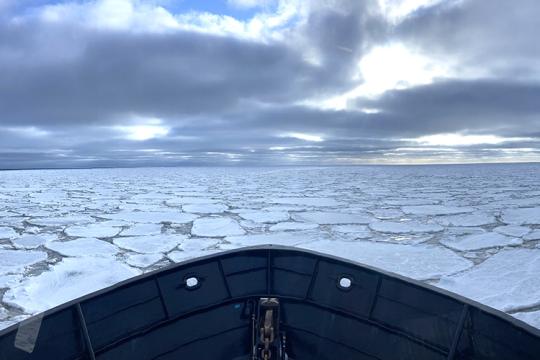 The research vessel Norseman II pushes carefully through the ice, maneuvering for open water. Credit: Gavin M Brady/NOAA Fisheries.
The research vessel Norseman II pushes carefully through the ice, maneuvering for open water. Credit: Gavin M Brady/NOAA Fisheries.
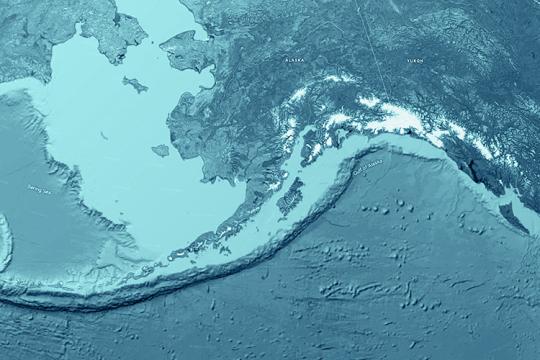 3D render and imaging of topographic map of Alaska showing the Gulf of Alaska, Aleutian Islands and Bering Sea. Satellite images courtesy of NASA. Credit: Frank Ramspott
3D render and imaging of topographic map of Alaska showing the Gulf of Alaska, Aleutian Islands and Bering Sea. Satellite images courtesy of NASA. Credit: Frank Ramspott
 Arctic Cod in tank. Credit: NOAA Fisheries.
Arctic Cod in tank. Credit: NOAA Fisheries.
Seafood Facts

Is Pacific Cod Sustainable?
U.S. wild-caught Pacific cod is a smart seafood choice because it is sustainably managed and responsibly harvested under U.S. regulations.
Availability
Year-round.
Source
U.S. wild-caught from Alaska, Washington, and Oregon.
Taste
Pacific cod is a mild-tasting fish.
Texture
Cooked Pacific cod is lean and flaky. Its moisture content is a bit higher than that of Atlantic cod, making the meat less firm.
Color
Raw Pacific cod is opaque and creamy white. Cooked cod is white.
Health Benefits
Pacific cod is a good source of low-fat protein, phosphorus, niacin, and vitamin B12.
Nutrition Facts
Servings: 1; Serving Weight: 100 g; Calories: 82; Protein: 17.9 g; Total Fat: 0.63 g; Total Saturated Fatty Acids: 0.081 g; Carbohydrate: 0 g; Total Sugars: 0 g; Total Dietary Fiber: 0 g; Cholesterol: 37 mg; Selenium: 36.5 mcg; Sodium: 71 mgMore Information
Cod Recipes
Looking for some ways to add cod into your rotation? If you need cooking inspiration, browse these recipes for Alaska cod potato-cakes, easy oven-fried fish sticks, and more!

Last updated by NOAA Fisheries on 03/20/2025
Seafood News
 Celebrate Culinary Arts Month with a sustainable seafood recipe for every month of the year.
Celebrate Culinary Arts Month with a sustainable seafood recipe for every month of the year.
What Your Birth Month Says About Your Next Seafood Recipe
 Fresh-caught taʻape on ice. Credit: Conservation International Hawaiʻi.
Fresh-caught taʻape on ice. Credit: Conservation International Hawaiʻi.
Reducing Waste and Feeding Communities in Hawaiʻi with a Whole Fish Approach
 Chef Tyler Hadfield’s Curried Skate Wings with Tomato-Masala Chutney
Chef Tyler Hadfield’s Curried Skate Wings with Tomato-Masala Chutney
Ring In the New Year With These Crowd-Favorite Seafood Recipes
 NOAA Fisheries, in collaboration with Blue Ocean Mariculture, is conducting a multi-year pilot study to evaluate observational methods and tools for studying Hawaiian monk seal behavior. Courtesy of Blue Ocean Mariculture
NOAA Fisheries, in collaboration with Blue Ocean Mariculture, is conducting a multi-year pilot study to evaluate observational methods and tools for studying Hawaiian monk seal behavior. Courtesy of Blue Ocean Mariculture
AI Meets Aquaculture to Study Hawaiian Monk Seal Interactions With Net Pens
Science Overview
NOAA Fisheries conducts various research activities on the biology, behavior, and population health of Pacific cod. The results of this research are used to inform management decisions for this species.
For detailed information about stock status, management, assessments, and resource trends, you can search for Pacific cod, and any other species of interest, using NOAA’s StockSMART web tool.
Pacific Cod Research in Alaska
Scientists at the Alaska Fisheries Science Center collect and analyze data needed to sustainably manage Pacific cod in Alaskan waters. Their ongoing research helps us understand the role this species has in Alaska’s complex marine food chain.
Pacific Cod in a Changing Climate
Climate change may be affecting the abundance of Pacific cod. Scientists at NOAA’s Alaska Fisheries Science Center and Oregon State University are working together to determine how climate change could impact growth and development of young Pacific cod in the Bering Sea. They are examining how temperature differences influence the timing and size of plankton blooms in the Bering Sea, which help determine the quality of habitat for Pacific cod.
Last updated by NOAA Fisheries on 03/20/2025
Documents
Pacific Cod Trawl Cooperative Program Small Entity Compliance Guide
The Pacific Cod Trawl Cooperative Program assigns Pacific cod harvest quota to qualifying…
Final Regulatory Impact Review/Environmental Assessment Review for Amendment 122 to the Fishery Management Plan for Groundfish of the Bering Sea and Aleutian Islands Management Area
This document analyzes several management measures that would apply to fishery participants in the…
Draft Regulatory Impact Review/Environmental Assessment for Proposed Amendment 122 to the Fishery Management Plan for Groundfish of the Bering Sea and Aleutian Islands
Regulatory Impact Review/Environmental Assessment for amendment 122 to the Fishery Management Plan…
Draft Regulatory Impact Review/Environmental Assessment for Proposed Amendment 122 to the FMP for Groundfish of the Bering Sea and Aleutian Islands
Draft Regulatory Impact Review/Environmental Assessment for Proposed Amendment 122 to the Fishery…
Data & Maps
2024 Gulf Of Alaska Ecosystem Status Report: In Brief
This assessment summarizes and synthesizes climate, biological, and fishing effects on the shelf…
Ecosystem Status Report 2024 Gulf of Alaska
This assessment summarizes and synthesizes climate, biological, and fishing effects on the shelf…
2024 Aleutian Islands Ecosystem Status Report: In Brief
This assessment summarizes and synthesizes historical climate and fishing effects on the shelf and…
Ecosystem Status Report 2024 Aleutian Islands
This assessment summarizes and synthesizes historical climate and fishing effects on the shelf and…
Research
Juvenile Pacific Cod Habitat Research
Researchers gather and evaluate data crucial for the sustainable management of Juvenile Pacific cod in Alaskan waters
2023 North Pacific Groundfish Stock Assessments
2023 North Pacific Groundfish Stock Assessment and Fishery Evaluation Reports for 2024 Fisheries
2022 North Pacific Groundfish Stock Assessments
2022 North Pacific Groundfish Stock Assessment and Fishery Evaluation Reports for 2023 Fisheries
North Pacific Groundfish Stock Assessments and Fishery Evaluation Reports
Alaska Groundfish Stock Assessments, Economic Status Reports, and Ecosystem Status Reports.
Outreach & Education
Recruitment Energetics and Coastal Assessment Program Flyer
This program is in NOAA Fisheries Alaska Auke Bay Laboratories.
Fisheries and Behavioral Ecology Program Flyer
This is a program in the Resource Assessment and Conservation Engineering Division.
Kimberly Ledger Seminar Flyer
A flyer for presentation by Kimberly Ledger during the 2024 Alaska Fisheries Science Center Seminar…
Zoe Almeida Seminar Flyer
A flyer for presentation by Zoe Almeida during the 2024 Alaska Fisheries Science Center Seminar…
Last updated by NOAA Fisheries on 03/20/2025
